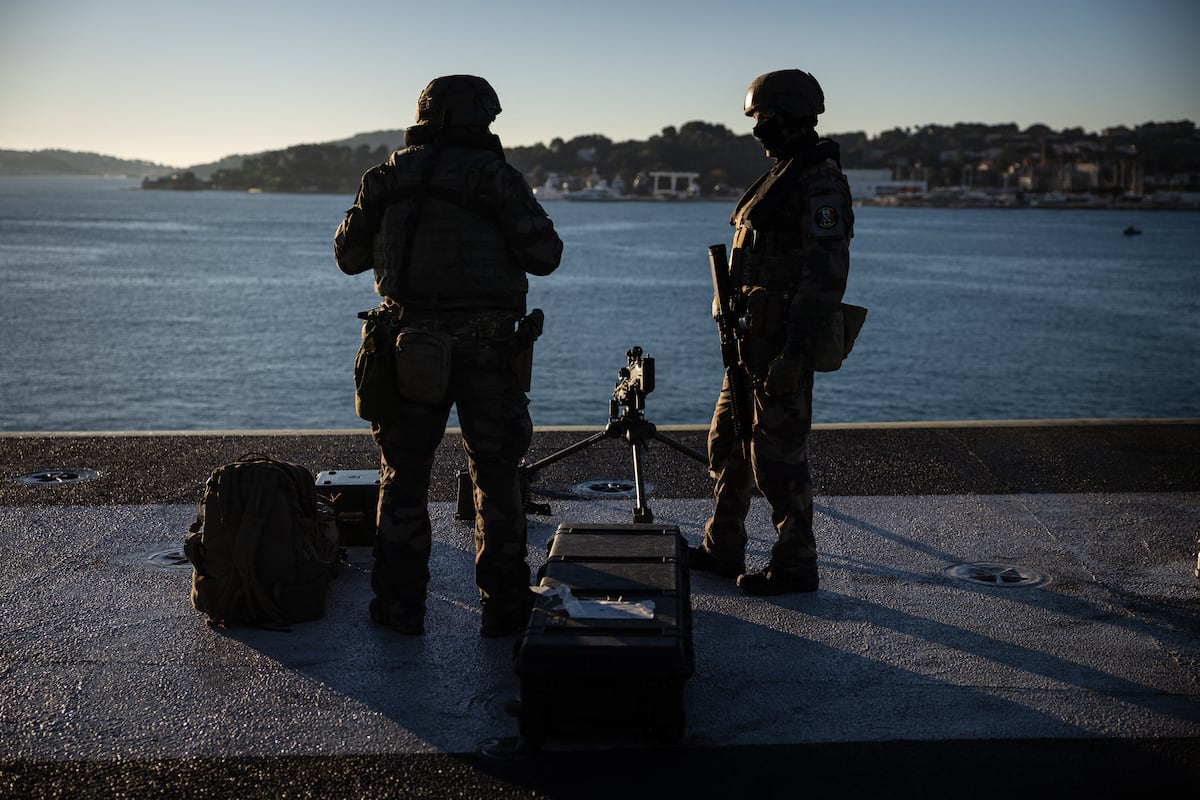How an Alaskan military base is preparing for Trump-Putin meeting. President Trump is set to host Russia’s Vladimir Putin tomorrow at Joint Base Elmendorf-Richardson, just north of Anchorage. The joint Air Force-Army base, which today supports F-22 Raptors, historically has been used to counter the Soviet Union and launch intercepts of Russian and Chinese aircraft.
The location begs questions about the logistics of securing the site. Base officials declined to answer any of them, deferred questions about preparation for the visit to the White House, which declined to provide further information, citing operational security.
But former Air Force officials said that with appropriate precautions, the base is well-suited to host the event. Ravi Chaudhary, a former assistant Air Force secretary for installations, echoed confidence that the base will be able to deliver a secure environment, though he expressed concern over the administration’s problems with security protocols. Defense One’s Audrey Decker has more, here.
Update: For the first time, European military industries are now contributing more for Ukraine than their U.S. counterparts, Defense News reported Wednesday citing new data from the German Kiel Institute for the World Economy. According to the latest figures, Europe has now contributed about $5 billion more than the U.S. going back to February 2022, when Russia launched its full-scale invasion of Ukraine.
Other notable takeaways:
- The U.S. remains the single-largest provider of infantry fighting vehicles, howitzers, multiple launch rocket systems, and air defense systems;
- Poland has provided Ukraine with the most tanks (354);
- Also: “many of the weapons now going to Ukraine come straight from the military-industrial output of the sending countries, rather than from preexisting stockpiles,” Defense News writes. Read more, here.
For this week’s recommended #LongRead, we suggest author Kevin Maurer’s extended meditation on the Army’s Best Ranger Competition, aka the “Ranger Olympics,” with an accompanying photospread by Kendrick Brinson for The Atlantic (gift link).
Maurer’s probably been to Afghanistan more times than you, and he co-wrote the first account of the bin Laden raid, “No Easy Day,” so he’s learned a bit about America’s special operations forces over the course of his two decades of coverage. Leveraging that deep background, this week he turned in an occasionally-ruminating account of what his Atlantic editors suggest “may be the hardest physical competition in the world.” (Note: Some ultra-endurance expedition races like this, e.g., would certainly come close, if not exceed the cumulative demands on the body and team. We recommend you read Maurer’s account and decide for yourself.)
A quick summary: “Over the course of three days,” 52 teams of two soldiers each “march and run dozens of miles, crawl through obstacle courses, and navigate swamps at night. They carry 50 pounds in their rucksacks, climb 60-foot ropes, and sleep, at most, for four hours at a time.” Only 16 teams made it to the competition’s third and final day.
One notable wrinkle: “[A]mong the 104 soldiers on the starting line at Fort Benning was a 25-year-old first lieutenant named Gabrielle White, a West Point graduate who was the first woman to compete for the Best Ranger title; and in part because, to her opponents on the course, the fact that she was a woman did not seem to matter,” Maurer writes, and added, “The only thing that mattered to the Rangers I met was that she had qualified for the competition.”
So who came out on top? Spoiler alert: “Both look[ed], a bit disconcertingly, like action figures,” Maurer writes. Read on to find out.
Additional reading:
Welcome to this Thursday edition of The D Brief, a newsletter dedicated to developments affecting the future of U.S. national security, brought to you by Ben Watson with Bradley Peniston. Share your tips and feedback here. And if you’re not already subscribed, you can do that here. On this day two years ago, Donald Trump was indicted for the fourth time in 2023 when he and 18 others were charged in Georgia for attempting to overturn the state’s results in the 2020 election.
Trump 2.0
National defense strategy check-in: As National Guardsmen are sent for a second time in recent months to a U.S. city whose local leaders made no requests for their support, we may be seeing the Trump administration’s new national defense strategy play out in unprecedented ways ill-matched to military capabilities, Defense One’s Meghann Myers reported Wednesday.
Currently, the administration is operating under an interim NDS that is “focused on defending the homeland,” with China and the Indo-Pacific a lower priority, Defense Secretary Pete Hegseth told the Senate Appropriations Committee in June. The interim NDS, which is classified, was finalized in March. An unclassified version exists but has not been released to the public—another change from the Biden administration, which published unclassified versions of both the interim and final NDS.
But civilian and uniformed Pentagon officials have said publicly that this administration is prioritizing the geographical U.S. in its national security policy, a departure from recent administrations that have described conflict with China in the Indo-Pacific or terrorism in the Middle East as the biggest threats to America. “I think we’re learning in real-time what that means,” Mark Cancian, a senior adviser at the Center for Strategic and International studies, told Defense One.
Big picture: What’s now playing out is the administration’s interpretation of domestic defense, Myers reports. Continue reading, here.
A second opinion: “[T]oday, general officers no longer seem to see themselves as guardians of the constitutional order,” warn former White House National Security Council members Steven Simon and Jonathan Stevenson, writing Wednesday for the New York Times.
Consulting history, author Garrett Graff combed through the many statements of German exiles and refugees who fled the country during the march of fascism in the 1930s. His retrospective, gleaned during research for his newest book, “The Devil Reached Toward the Sky: An Oral History of the Making and Unleashing of the Atomic Bomb,” at times reflects similar questioning contemporary officials and scholars may find themselves pondering—including questions like, “When should we resign? Now? Maybe it’s not bad enough yet? But when?”
Related reading: “Trump Has a New Definition of Human Rights,” historian Anne Applebaum writes for The Atlantic in response to new reports from Trump’s State Department. Topline read: The State Department’s revised reports “contain harsh and surprising assessments of democratic U.S. allies, including the U.K., Romania, Germany, and Brazil, and softer depictions of some dictatorships and other countries favored by Trump or his entourage,” like El Salvador and Israel, Applebaum writes.
“The State Department’s motivation is not hard to guess,” says Applebaum. “Because the Trump administration is sending prisoners to El Salvador, the department massaged the report to avoid the glaring truth: The U.S. is endangering people by sending them to Salvadoran prisons.” More, here.
Foreign aid update: The White House can continue withholding congressionally-appropriated funds, for now. A federal appeals court ruled 2-1 Wednesday (PDF) that the Trump administration can decline to disperse billions in foreign aid earmarked by Congress, including $10 billion for global health programs through 2028.
One catch: “[T]he panel of judges did not rule on whether the terminations of funds appropriated by Congress were constitutional,” NPR reports.
Said an attorney for those suing the administration: “[O]ur lawsuit will continue regardless as we seek permanent relief from the Administration’s unlawful termination of the vast majority of foreign assistance. In the meantime, countless people will suffer disease, starvation, and death from the Administration’s unconscionable decision to withhold life-saving aid from the world’s most vulnerable people.” More, here.
Deportation nation update: Recruitment meme edition. Dozens of memes used by White House social media accounts appear designed “to normalize mass deportation and Christian nationalist narratives,” experts told WIRED, reporting Tuesday.
And “DHS is recruiting using a not-so-subtle reference to a 1978 book from white nationalist William Gayley Simpson,” observed researcher Hannah Gais of the Southern Poverty Law Center, writing Tuesday on social media.
Additional reading:
Read the full article here








Leave a Reply